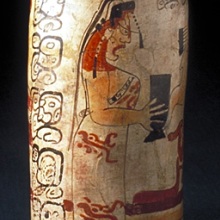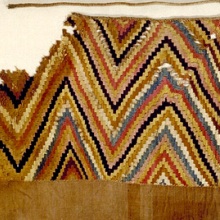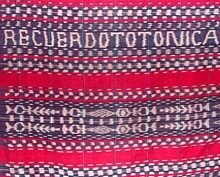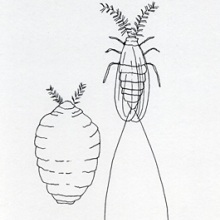learn how
Ancient Techniques - Textiles - Raw Materials

Except for scant fragments found archaeologically, the textiles created by ancient Mesoamericans have not survived. In the Maya region for instance, much of what we have learned about ancient clothing comes from depictions of textiles on ceramics, stone sculpture and other durable remains.
From these examples, we know that Maya cloth, like that of their neighbours, was probably made of natural brown and white cotton (Gossypium barbadense) and agave fibres. Today sheep's wool, introduced by the Spanish, is used in some of the highland areas for weaving.

In Peru, cotton was also used on the coast. Due to the dry coastal desert conditions, many thousands of fine textiles have survived in burials in the coastal sand dunes. Andean cultures also used wool from the highland camelids to produce their cloth; the example on the left made by the Chancay culture (c. A.D. 1200-1550) is made of alpaca wool and cotton. The silky wool of the alpaca was highly prized for its ability to take dyes readily, and was traded and used in the finest textiles in both the highland and lowland cultures. Bast and other hard fibres were used for cordage, knotted netting and braiding.

In the Maya area, scholars have suggested that colours were at times applied as paint to textiles. Cinnabar, which produces an orange-red colour, has been found painted on textiles in a tomb in Rio Azul. In post-conquest times, indigo, which produces blue, was procured from the plant Indigofera. At left is a contemporary example of an indigo dyed cloth from Guatemala. Purple was obtained from the secretions of the mollusks from the genera Purpura patula L. and was used on cotton; traces have been found in the ancient textile fragments.
Image: Woman's tube skirt, warp ikat (tie-dyed). The woven text reads: RECUERDOTOTONICAPAN ("Souvenir of Totonicapán"). Made in Guatemala c. A.D. 1930 (T94.0977).

Indigo was also used in Peru. There, and in the Maya area, the colour red was obtained from the female cochineal insect Dactylopius coccus, which lives on the nopal cactus. A plant which resembles European madder may have also been the source of red dye in ancient Peru. Yellow came from the molle, chilca and taro trees of coastal valleys in Peru. Black was obtained from logwood and brown came from the bark of the nance tree in the Maya area.

COCHINEAL (Dactylopius coccus) - A brilliant red dye is produced from cochineal insects, which feed on the prickly pear cactus (Opuntia) - in particular, the species called nopal. The insects manufacture a rich maroon pigment and they store this pigment in body fluids and tissues. The dye properties of cochineal were discovered by ancient indigenous groups who would dry the female insects in the sun, and then grind the bodies to produce a powder. Depending on the mordant used, dyers could achieve not only beautiful crimsons and pinks, but also near-black and even purple shades. To produce one pound of cochineal powder, it took 70,000 dried insects. An acre planted with nopal cacti yielded 100 to 150 kg of cochineal powder.